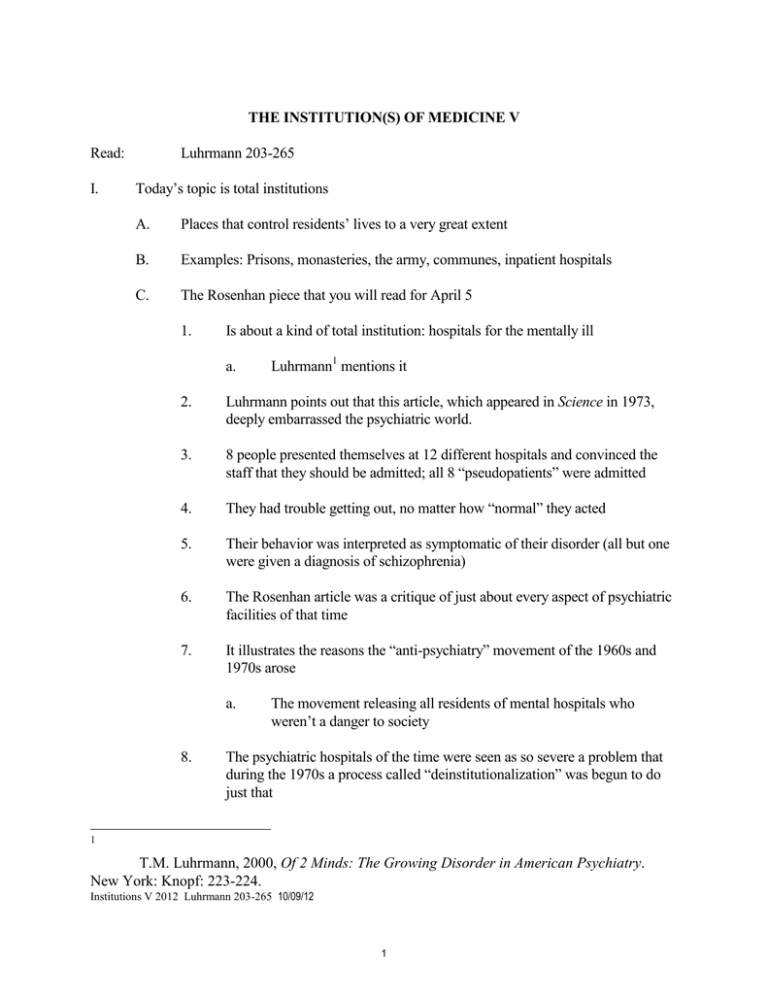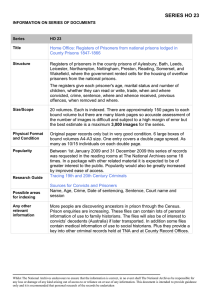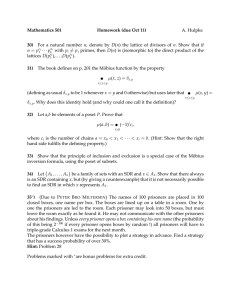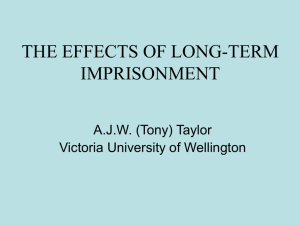Read: Luhrmann 203-265 I.
advertisement

THE INSTITUTION(S) OF MEDICINE V Read: I. Luhrmann 203-265 Today’s topic is total institutions A. Places that control residents’ lives to a very great extent B. Examples: Prisons, monasteries, the army, communes, inpatient hospitals C. The Rosenhan piece that you will read for April 5 1. Is about a kind of total institution: hospitals for the mentally ill a. Luhrmann1 mentions it 2. Luhrmann points out that this article, which appeared in Science in 1973, deeply embarrassed the psychiatric world. 3. 8 people presented themselves at 12 different hospitals and convinced the staff that they should be admitted; all 8 “pseudopatients” were admitted 4. They had trouble getting out, no matter how “normal” they acted 5. Their behavior was interpreted as symptomatic of their disorder (all but one were given a diagnosis of schizophrenia) 6. The Rosenhan article was a critique of just about every aspect of psychiatric facilities of that time 7. It illustrates the reasons the “anti-psychiatry” movement of the 1960s and 1970s arose a. 8. The movement releasing all residents of mental hospitals who weren’t a danger to society The psychiatric hospitals of the time were seen as so severe a problem that during the 1970s a process called “deinstitutionalization” was begun to do just that 1 T.M. Luhrmann, 2000, Of 2 Minds: The Growing Disorder in American Psychiatry. New York: Knopf: 223-224. Institutions V 2012 Luhrmann 203-265 10/09/12 1 9. Unfortunately, the infrastructure to care for them in the community was never built 2 D. II. Resulting in our very sorry present situation b. Luhrmann does a good job describing the consequences A more general lesson of the Rosenhan piece has to do with 1. E. a. The remarkable power total institutions can have: a. To define people b. To decide their future c. To justify institutional decisions with compelling ideologies The Stanford Prison Experiment Characteristics of total institutions A. Some are voluntary, some are not 1. 2. B. Patients might have voluntarily admitted themselves to inpatient psychiatric hospitals a. Ken Kesey’s One Flew Over the Cuckoo’s Nest,2 about a psychiatric facility b. The protagonist is very surprised to discover that all the other patients on his ward are voluntary admits c. He can’t understand why they don’t leave DISCUSS: the situation in the psychiatric units in “Back from Madness” All total institutions have elaborate induction ceremonies 1. Can be usefully compared to initiation ceremonies in small-scale societies a. 2. Ritually marks a serious change of status, identity DISCUSS: what induction rituals are found in regular hospitals? 2 Ken Kesey, 1962, One Flew Over the Cuckoo’s Nest, New York: Viking Press. A play and a movie were made from this novel. 3 a. A legal bracelet, you sign away certain rights, other rights are carefully protected b. Privacy is “invaded” 1) C. Remarkable degrees of power over residents 1. A book by Allan Young, reporting on his research in a Veterans Administration hospital3 2. Illustrates the power of the staff (the higher administration) to compel patients to present themselves in a manner that fits the higher administration’s construction of what is wrong with these men, including its cause: a. 3. 4. Post-traumatic stress disorder Many of the men, similar to the example mentioned above in the Kesey novel, wanted to stay in the hospital a. III. Patient is assigned new clothing that permits ease of access And so they reported the symptoms they knew they were expected to report Young clearly doesn’t accept this diagnosis and its presumed etiology a. Which is why his title says “inventing post-traumatic stress disorder” b. This doesn’t mean he thinks there are no symptoms, no suffering c. The book analyzes how PTSD in that hospital in particular, has been culturally constructed Another kind of total institution: the super-maximum prisons, also known as “control units,” in Washington state A. A book by Lorna Rhodes4 analyzes the psychiatric facilities in these prisons 3 Allan Young, 1995, The Harmony of Illusions: Inventing Post-Traumatic Stress Disorder. Princeton: Princeton. 4 Lorna A. Rhodes, Total Confinement: Madness and Reason in the Maximum-Security Prison. Berkeley: University of California Press, 2003. 4 1. Obviously prisons, of all total institutions, control the residents most a. B. C. And among prisons, these “supermax” prisons exert the most control The rationale for these “supermaxes”: 1. Other penal institutions have failed to control some “problem” inmates, so they’re shipped off to these supermax facilities 2. These are men who “have nothing to lose” and have a record of not following the rules at the other prisons 3. Considered to be a danger to themselves and others These institutions’ logic 1. The ideal is to totally control the body without hurting it a. So, these institutions take care of the body—feed it, nurse it back to heath when it falls sick, protect it (keep it from doing damage to itself) b. Here we have the opposite of a policy of corporal punishment, the opposite of physical torture 2. The goal of staff is to deal with the person living in the body as minimally as possible 3. Total isolation and total curtailment of movement a. The super-max prisoner’s body has minimal contact with other bodies—guards use cuffports for putting on prisoners’ handcuffs, use glassed-in visiting booths with microphones, etc. 1) b. Which are more generally used in prisons: we saw one in the “Back from Madness” video when Tod was in jail This minimal contact is said to be a “rational” precaution—justified as a means to lessen risk to guards and other prisoners 4. Super-max prisoners are never to be with the other prisoners in the unit 5. Super-max prisoners are totally dependent on the guards, who give them 5 food, take them to showers, and to the 1 hour of exercise per day they are permitted a. 6. D. Which they carry out in little fenced-in cubicles Some guards believe it’s best to never let the prisoners see them, to always wear their suits (which are like wet suits) and masks a. A kind of Robo-Cop impression b. Guards say that this way of presenting themselves is the most “professional” c. This attitude is an example of super-maxes’ general goal of eliminating personal interaction, contact (even eye contact), etc., as much as possible The logic breaks down when dealing with some kinds of prisoner behavior 1. It’s often difficult to distinguish between “mad” prisoners, who aren’t to blame for their acts because they aren’t choosing to do them, and “bad” prisoners, who do choose, and therefore are to blame 2. Rhodes says that staff uses DSM IV consistently to make the distinction 3. She points out a nice congruence between these units’ logic and DSM-IV a. Both deal with bodies, not with persons b. DSM-IV has totally abandoned any attempt to deal with the person 1) E. Remember, Luhrmann’s point that it classifies according to symptoms, there is no attempt to use theories about etiology Examples of the dilemmas with this subset of prisoners: 1. Some prisoners will exhibit what’s called “behavior”; there are 3 kinds: a. They throw feces and spray urine on the guards b. They refuse—to eat, to move, to do anything c. They self-mutilate—spatter their blood on the walls, etc. 6 2. Precautions are taken to keep this “behavior” at a minimum a. F. For example, prisoners are given plastic utensils So, are these men sick or well? 1. If a “behaving” prisoner is sick, he is seen as not responsible for his acts and needs to go to the mental health unit a. 2. Self-mutilation, smearing feces, going limp, etc., certainly seem symptomatic of something The other argument is that they are indeed choosing to engage in these acts a. As also happens in the veteran’s hospital described by Young, and hospitals discussed by Luhrmann, some super-max prisoners prefer the clinic to their cell b. So, the explanation goes, they engage in this “mad” “behavior” so that they can get taken to the clinic c. Another explanation is that prisoners want to disrupt the system, and, this being a super-max, their ability to do so is limited to these 3 “behaviors” 1) c. Or perhaps they act out of pure rage, but, again: 1) 3. They are seen to be choosing to “make bad choices,” to express their rage this way and not another way Remember Luhrmann’s discussion of DSM IV Axis II? a. G. Rhodes documents just how disruptive such “behavior” is With Axis II the problem is not considered to be environmental, but characterological, lying within the prisoner and very unlikely to respond to therapy Rhodes’s analysis 1. That in fact much of the “behavior” results from prisoners being deprived of their dignity and personhood 2. And that no matter how much institutions try to impose a scheme to 7 rationally classify and control some aspect of real life, contradictions and paradoxes will be revealed 3. a. Bodies turn on themselves b. Rather than, as intended by the system, become docile bodies c. Which, the theory holds, produce docile and acquiescent minds d. DISCUSS: body disciplines that are said to influence the mind? Rhodes discusses the long history of penal reform theories and how these theories remain, like ghosts, in present-day policies a. The theory proposed by Jeremy Bentham5 that total isolation will result in the psyche’s improvement b. And the theory that correct architecture will lead to positive change 4. Many medical theories through the ages have connected health to proper environment (defined in many, and diverse, ways) 5. Here is an institution that claims to be superior to previous ones because it: a. Does not harm the body; takes care of it when sick b. Rationally classifies the prisoners (the crazies go to mental health facility) c. The facilities are said to be ideal: 1) 6. 5 Well-lit (lights stay on 24 hours), transparent, sterile, ordered, etc. However, those super-max prisoner bodies subvert the system; an observer sees, hears, and smells evidence of this subversion: a. Prisoners are yelling all the time b. “Throwing” feces and urine creates a permanent smell, even the suits the officers must put on to “extract” a prisoner from his cell smell bad Jeremy Bentham, 1843. The Works of Jeremy Bentham, ed. Bowring, Vol. IV. 8 c. 7. And so these bodies subvert the predictions of the supermax’s logic a. 8. Prisoners resist that logic with the one tool they have—their body 1) And even though the options are extremely curtailed, they resist as best they can 2) Docile bodies—“going limp”—can be a form of resistance Despite not ever hurting the body, the raw power of supermaxes over these bodies is ever-present a. H. The presence of “behavior” itself And invites challenges to it Very fundamental issues concerning human nature, free will, etc., arise in these settings 1. For example, the use of belts that can deliver serious shocks when activated by a stun gun in prisons a. Allow for more freedom of movement 2. Amnesty International says use of these belts is torture 3. Proponents say no, because all a prisoner has to do is obey the law, which precisely stipulates just what obedience consists of a. 4. If you want to argue that supermax prisons’ extreme isolation, or use of the threat of 50,000 volt shock is “cruel and unusual” punishment a. 5. And therefore wearing these belts is different from being forced by torture to talk, etc. Then you need to have a concept of the person, and not only of the body and how its needs must be met Paradox and contradiction a. These bodies use themselves to resist b. They disprove George Orwell’s thesis in 1984 and Bentham’s (see 9 above) and other writers 1) 6. IV. That a certain kind of corporeal punishment will inevitably soften the mind c. Someone who spatters his own blood on the wall is either mentally ill d. Or we have to throw our notions about Rational Man out the window e. The prison ethos will admit neither: 1) Its reason for existing depends on the presumption that its clientele is rational 2) In the sense of being able to choose to make bad choices So, Rhodes suggests, these stark cases force us to think about individuality, choice and rationality—free will a. About our notions of agency, our notions that autonomy is a healthy state b. And about just how much social, human contact is needed for someone to be able to maintain being “normal” Final comments on Descriptive versus Prescriptive A. Social science analyses often appear to be extremely critical of total institutions B. It’s not hard to see why: institutions are self-serving, self-protective, myopic, resistant to change, indifferent in the way only fully “rational” bureaucracies can be, and obsessed about structure 1. But, again, the proper way to look at these analyses of institutions is not strictly on moral terms 2. But as description and analysis of them as institutions, exhibiting the characteristics we have outlined during the last 2 weeks 3. Moral judgments can come into play, and citizens should certainly consider the moral issues a. Rosenhan et al. are clearly morally passionate members of the anti- 10 psychiatry movement 4. 5. But our understanding will be foreshortened if we get caught up in an exclusively moral analysis a. There are good hospitals and bad, and this can make a lot of difference b. But my point today and last time is that if you stop your analysis at judging the individual doctors involved in the Tuskegee Study as morally wrong, you’re stopping short Those supermax guards who never want a prisoner to see their faces aren’t necessarily doing this because they’re brutes a. Rather, they are carrying the institutional reasoning to its logical end 11 MIT OpenCourseWare http://ocw.mit.edu 21A.215 Disease and Health: Culture, Society, and Ethics Spring 2012 For information about citing these materials or our Terms of Use, visit: http://ocw.mit.edu/terms.






